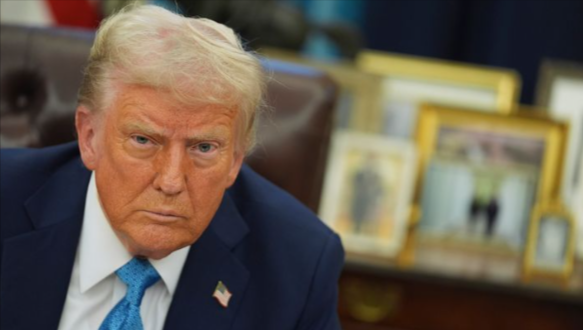Trump White House Planning 'Largest Tax Cut in History for Middle Class'

White House press secretary Karoline Leavitt stated on Thursday that President Donald Trump aims to implement the “largest tax cuts in history” for middle-class Americans.
Leavitt's remarks coincided with Trump’s meeting with congressional leaders at the White House, where they discussed provisions for a budget reconciliation bill expected to feature various tax reforms.
During Trump’s first term, Congress utilized the budget reconciliation process to pass the 2017 Tax Cuts and Jobs Act.
Trump has expressed a desire to make those tax cuts, most of which are set to expire next year, permanent.
According to The Wall Street Journal, some congressional Republicans are considering a five-year extension to mitigate costs when the bill is assessed by the Congressional Budget Office, which operates on a ten-year scoring window.
A reporter questioned Leavitt, asking, “Would [Trump] sign a bill that just has a five-year extension?”
Rather than giving a direct response, Leavitt emphasized the president’s tax priorities for Congress to address within the legislation.
“No tax on tips, which is obviously a very public campaign promise the president made,” Leavitt stated. “No tax on seniors’ Social Security. No tax on overtime pay. Renewing President Trump’s 2017 middle-class tax cuts.
“Adjusting the SALT cap. Eliminate all the special tax breaks for billionaire sports team owners. Close the carried interest tax deduction loophole. Tax cuts for made-in-America products.
“This will be the largest tax cut in history for middle-class, working Americans,” Leavitt emphasized. “The president is committed to working with Congress to get this done.”
The first three components—exempting tips, Social Security benefits, and overtime pay from taxation—are straightforward.
A significant middle-class feature of the 2017 tax cuts was the near-doubling of the standard deduction. Single filers saw an increase from $6,500 to $12,400, while married filers saw their deduction rise from $9,500 to $24,800. Essentially, income up to those thresholds became exempt from federal income taxes.
Additionally, the legislation doubled the child tax credit from $1,000 to $2,000 per child. Tax credits are applied directly to a taxpayer’s owed amount, reducing it dollar for dollar.
Moreover, up to $1,400 of the credit is refundable. This means that if a taxpayer owes the federal government $1,000 and has one child, the $2,000 tax credit covers the entire bill and provides an extra $400 as a tax refund.
Leavitt also referenced the SALT cap, which limits the amount of state and local taxes that can be deducted from federal taxes when itemizing deductions instead of opting for the standard deduction.
For taxpayers with substantial deductions—such as mortgage interest payments and charitable contributions—itemized deductions may exceed the standard amount.
The 2017 Tax Cuts and Jobs Act imposed a $10,000 cap on deducting state and local taxes, disproportionately affecting residents of high-tax states like California, New York, and New Jersey.
Republican lawmakers from these states are likely to push for a higher cap in exchange for their support, according to Roll Call, and Leavitt’s remarks signaled that Trump is aligned with that position.
Additionally, “The carried interest deduction allows investment managers to pay a lower capital gains tax rate on the income they receive from their work as compensation. It’s no small matter, with many capital gains subject to 23.8% taxes while the rate for regular wage income can be double that,” as reported by Yahoo Finance.
According to Bloomberg, Leavitt’s comments marked the first public acknowledgment from the Trump administration regarding plans to close the carried interest deduction loophole or eliminate tax breaks for sports team owners.
Finally, Leavitt’s mention of tax cuts for American-made products pertains to a campaign proposal Trump introduced while addressing the Economic Club of New York in September.
Trump’s plan involves “a reduction in the corporate tax rate from 21 percent to 15 percent, solely for companies that make their product in America.”
He contended that this policy would incentivize domestic manufacturing, leading to job creation.
A 2023 report by economists from Harvard, Princeton, the University of Chicago, and the U.S. Treasury found that Trump’s corporate tax reforms effectively stimulated economic growth.
The Wall Street Journal’s James Freeman summarized findings from the 51-page National Bureau of Economic Research report, noting that the 2017 Tax Cuts and Jobs Act triggered a surge in business investment that significantly boosted the economy.
Trump’s tax cuts permanently lowered the corporate tax rate from 35 percent—which was the highest among industrialized nations—to 21 percent, bringing it slightly below the average rate in developed countries.
The resulting increase in business activity due to the reduced tax rates led corporate tax revenues to rise from approximately $230 billion in 2017 to $445 billion in 2023.
The Hill reported that House Speaker Mike Johnson described Thursday’s meeting between Trump and GOP lawmakers as productive, and he expects the House Budget Committee to commence work on a budget resolution as early as next week.